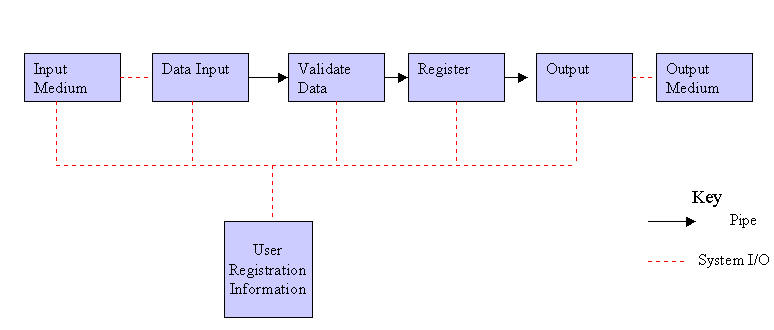|
Registration Sub-System (Pipe and Filter Architecture)
Explanation
Input Medium
The input medium for the
Registration sub-system is the user agent (client application) that sends
the request for the registration web page (HTML file) to the web server.
Once the web server transfers the HTML document to the user agent (web
client) the registration screen appears to the user with text boxes
to collect user registration information such as the username, password,
first name, last name, street address zip code, and club membership. After
the user enters the requested information, the input medium (user agent)
accepts the information as input for the system.
Data Input
After the input medium captures the user information such as username,
address, and membership selection. The captured user information
is then sent to the data input filter. The data input filter performs
client side checks on the information to verify that the user name and
address are in the correct formats. If the format is correct the input
data is sent to the validate data filter. Otherwise, a flag of INVALID data is sent to the
validate data filter.
Validate Data
The
validate data process performs server-side validation of the user
registration information to ensure the same user does not register multiple
times. This is accomplished by checking the validity of the of the user
name, address, and private membership type with the Golf Track users
database registry (data storage details are described in the data storage
section) to ensure that it is not a duplicate entry. If duplicate entries of
the user name, address, and membership type, are detected an UNSUCCESSFUL
flag is sent to the Register filter. However, if no duplicate entries exist in
the Golf Track database registry the data for user name, address, and
membership type is sent to the Register filter for further processing.
Register
The register process stores the
user information in the database registry (via processes that interact with
the Database Management System described in the Data Storage section)
if the user name, address, and membership type data is received from the
validate data filter successfully. After storing the user information, it
then sends the confirmed user name (member identification) and password for
the new user to the Output filter for further processing. On the other
hand, if the Register filter receive the unsuccessful flag from the validate
data filter it sends an EXISTING member flag to the output filter.
Output
The output filter formats the output at HTML documents to send to the Output
Medium (User Agent). In other words, the HTML document is created based on
the data received from the Register filter. If an EXISTING member flag is
received, a HTML page that redirects the user to the Login screen for
Current Members is created. If it is data for a new user the output filter
creates a HTML document that contains the new user's member information
(i.e. username and password) and hyperlinks to help information on how to
use the Online Golf Handicapping System.
Output Medium
The output
medium, which is the user agent, displays the formatted HTML output that
it received from the output filter.
DESIGN
RATIONALE
|
